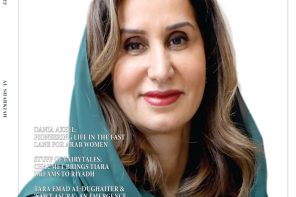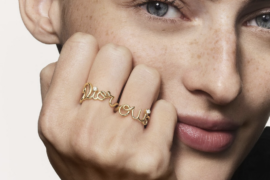Rahma Farahat is an art director and production designer, who uses her knack for design to tell stories beyond the script. She has worked on “Captain Marvel” (2019), “Pokemon Detective Pikachu” (2019) and “Perry Mason” (2020) just to name a few. Born to a Saudi father and a German mother, she was raised in Saudi Arabia and is a part of a new generation of women to watch.
As an artist you represent the next generation of female production designers. How would you say the field is changing?
As a field that has been dominated by men for generations, I am seeing a big shift in the art department in recent years. The younger generation is starting to shift their focus into these positions as people begin to learn more about the art department and what a Production Designer and Art Director does, and the various positions within the department that are needed to make a movie or TV show. More and more women are starting to take up these roles as the old generation is retiring and the old way of doing things is changing.
Can you sum up what you do in one line?
As a Production Designer, I take all the ideas communicated in the script and translate them into a visual language on the screen.
As an Art Director, I manage a team of artists and make sure that all the ideas are being executed to the Designers vision.
You were brought up in Saudi Arabia, will you be working in the future on Saudi films?
I hope so! That would be amazing. I would love to work in my country and with my people to bring stories that are so uniquely ours and show them to the world.
The Saudi movie industry is looking bright. What is your impression of the country’s film industry?
There is so much happening right now, and I am so proud. To see the upward movement happening in the film industry in Saudi Arabia right now is really exciting, and I hope to be part of establishing these Saudi voices and Saudi stories on a worldwide scale. There is still a lot of work to be done, but it’s going in the right direction. As long as there is interest in the young generation, it will keep growing.
Have you worked with any Arabic productions?
I worked on a short film in Jeddah some years ago. I was visiting my family during my summer break from University and this opportunity to work on a short film called “Fatin Drives Me Crazy” came up, and I couldn’t say no. The film is about a young woman who decided to drive a car to go to the store to get some things she needs – this was before it was legal for women to drive in Saudi Arabia, and it was such a great experience to be a part of a movement within the country like that.
I have also worked with Saudi directors on projects in the US, when they wanted to bring a Saudi and Arabic element and ideas into the design. I hope to be able to do more projects like that, and to work in Saudi Arabia again as more and more stories come out with authentic Saudi voices.
Set design is an unusual branch of creativity as it’s rarely taught in schools. What steps did you take in order to become an Art Director?
It’s funny that considering how Production Design is a big part of making a film or TV show, yet very few schools teach and focus on it. Having grown up watching a lot of design shows and building doll houses and furniture and decorating and redecorating my room every few months when I was bored, I was really interested in the design field, but also wanted to study film. So, while in college, I took design classes alongside my film ones and tried to incorporate what I was learning about interior design into my film projects.
How did it feel to be working on such huge and important productions?
I am so grateful that I have the opportunity to work on such big productions where I am surrounded by great artists and great people that teach me every day, from how to be a better artist to communication and how to bring a good team together, and how to have fun on the job. We work a lot, and our job requires long hours, but it’s great to know that the work I put in will be seen by people around the world.
How do you keep your ideas and concepts fresh?
I am always open to exploring new places, new lands, new ideas. Travelling and seeing how other people live broadens the mind like nothing else. Studying human behaviour, psychology, philosophy and understanding why humans gravitate to certain aesthetics and notions is all part of expanding the mind and our ideas.
What is important for you to create an authentic and original stage set?
To create an authentic set, I think the first step is understanding the characters that these sets are being designed for. Understanding people and behaviour leads you to understanding the space around them. We have to go inside this character’s mind to appreciate the decisions they make from the way they decorate their home, to what kind of car they would drive, how neat or messy they are, etc. Everything gets analysed to give the most authentic look possible, that the audience will believe. And within all that analysing, we also try to create a world that is visually appealing and can communicate with the audience what isn’t spoken. After all, this medium is all about visual communication, and the more information we can give the audience from set, the better.
What do you love most about what you do?
I love the collaboration on a film set between so many different people and so many different departments. You get people from all different walks of life and throw them together in a room with a script, and to see each person bring their own perspective and life experience into it and how those ideas get moulded together into one cohesive concept is really spectacular. For that reason, no two projects are ever exactly the same because with each experience we all grow a little and change, and on the next one we will have learned from our previous project.
What would you say is the future of production design? Where do you see the field going?
With all the digital technology being developed right now, for example the use of LED screens in the Disney show The Mandalorian, the industry is slowly shifting to using virtual sets and digital technologies for world building. However, that technology is still expensive and will take a long time to be the norm in the industry. The technology will keep developing over many years, but no matter how it changes, the basic need for building a world and creating sets, whether virtual or physical, will never go away.
Thank you so much for taking your time for us, we admire you and your work and are very proud to have had this moment with you. We wish you all the best success and happiness and your career and life.
Text by Suna Ahmed







